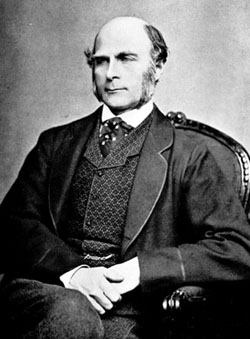The Gentleman Traveler
Today, we travel the wilds with the highborn. The University of Houston's College of Engineering presents this series about the machines that make our civilization run, and the people whose ingenuity created them.
 Sir Francis Galton was Charles Darwin's half cousin -- 13 years younger than Charles. Not only was Francis born to wealth, he became a genius polymath. But, at 33, he wrote his first book on The Art of Travel. Before we open it, let's see how Galton spent the rest of his 89 years -- after his early years of education and travel. Something happened when cousin Charles published On the Origin of Species.Darwin's first chapter on "Variation under Domestication," appears to have lit a fire under Galton.
Sir Francis Galton was Charles Darwin's half cousin -- 13 years younger than Charles. Not only was Francis born to wealth, he became a genius polymath. But, at 33, he wrote his first book on The Art of Travel. Before we open it, let's see how Galton spent the rest of his 89 years -- after his early years of education and travel. Something happened when cousin Charles published On the Origin of Species.Darwin's first chapter on "Variation under Domestication," appears to have lit a fire under Galton.
Does environment shape us? Or genetics? Can we shape our own human species? He went on to study, and write extensively, about a field which he himself named. It was eugenics.
We've viewed that word with revulsion ever since the Nazis -- even though most of us, when we select our mate, look for characteristics we want in our children. In the tension between nature and nurture, Galton thought his cousin had tipped the balance toward nature -- or breeding. And, sure enough, when he studied genealogy, he found that certain qualities carried on in successive generations. But he also found flaws in that idea.
He was greatly interested in mathematical statistics. It was he who framed the idea of statistical regression. He found that qualities like intelligence or height all tended to regress toward the mean over time. Mating might sustain some feature in the short term (whether through nurture of nature); but, over a few generations, offspring tended to return to the mean of the population.
Galton also looked for clues in human fingerprints. He established fingerprints as a means of identification, and he created our system for classifying them. But he never could connect fingerprints with our other characteristics.
So back to his book on travel: This is no Fodor Guidebook. As a young man, he'd mounted serious expeditions into far corners of Africa and Asia. He explains how to organize and provision a safari, how to see after our own creature comforts, how to endure in the wilds for months -- years -- at a time.
Let the bearers bring their women, he advises (women can carry as much as men and they complain less.) If you poison yourself you'll need an emetic (you can use a thimbleful of gunpowder in warm water.) He helps us calculate how many horses we'll need -- or mules, dogs, camels, or elephants. He tells how we might cut open our arm, secret jewels in it, and let the wound heal over. He is very thorough in anticipating our many trials along the way. And the Royal Geographical Society honored him for his expeditions.
One biographer calls Galton the last of the gentlemen scientists. He had the wealth to fund an expedition, or to hire help with an experiment. He was enormously bright, but he never held an academic or professional position. And he appears to've wondered why everyone in the world couldn't be a specimen just as fine as he.
I'm John Lienhard, at the University of Houston, where we're interested in the way inventive minds work.
F. Galton, The Art of Travel: Shifts and Contrivances in Wild Countries.This book was first published in London in 1855. For an annotated partial reprint of a later edition, see: The Art of Rough Travel. Kitty Harmon, ed. (Seattle, WA: The Mountaineers Books, 2006)
N. T. Gridgeman, Galton, Francis. Dictionary of Scientific Biography,C.C. Gilespie, ed. Vol. 5 (New York: Charles Scribner's Sons, 1972): pp. 265-267.
For more on Galton, see: https://en.wikipedia.org/wiki/Francis_Galton ; and for more on eugenics see: https://en.wikipedia.org/wiki/Eugenics . Galton's photo above is courtesy of Wikipedia and in the public domain.

Galton's 1862 book, Hereditary Genius includes this graph of male heights. Here he correctly diagnoses the bell curve and measures of its dispersion (or standard deviation.) Notice that, in the mid-19th century, the average height was 5 ft., 6 in.